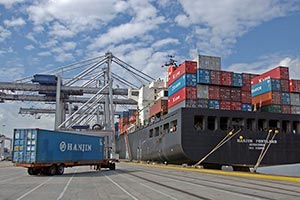Truckers Face Wide-Ranging Challenges From Stranded Hanjin Freight

Truckers who are being challenged on multiple fronts by bankrupt Hanjin Shipping’s stranded cargo that they already have are facing additional obstacles as U.S. ports take a variety of approaches to accepting or releasing the Korean carrier’s goods that are on the docks or afloat nearby.
Terminals at Long Beach, California, the second-largest U.S. container port, aren’t accepting more Hanjin cargo, though two are allowing truckers to haul boxes already there if payment arrangements have been made. Three of its ships are anchored off the Southern California coast. In Seattle-Tacoma, one of the five largest ports, terminals aren’t accepting any Hanjin cargo.
Maher Terminals in New York-New Jersey, the biggest East Coast port, said Hanjin imports will delivered only if paid for in cash or with established credit. The terminal at the third-largest U.S. port said loaded exports or empty containers won’t be accepted.
The Port of Charleston, South Carolina, is accepting empty returns starting Sept. 2, but export loads won’t be accepted and imports discharged on or after Sept. 1 won’t be released until $350 in terminal costs are paid and Hanjin as well as the cargo owner agree to those terms. The Port of Virginia isn’t accepting Hanjin cargo but will take empties at one terminal.
Hanjin, which carries about 8% of Transpacific container trade, was the most visible ocean carrier failure in three decades, following long after U.S. Lines closed its doors in the mid-1980s, faced with the same overcapacity in ocean freight markets. The Korean carrier struggled in an industry where rivals such as Maersk Line and Mediterranean Shipping Co. built far larger ships. and then cut freight rates as available container capacity far outstripped weakening demand.
“Any blue [Hanjin] box is coming to a grinding halt," said Dan Smith, a principal at Tioga Group, which specializes in intermodal freight consulting, as marine terminals choose not to release or accept cargo.
RELATED: Hanjin ships get stranded in high seas, roiling supply chain
An additional complicating factor is that Hanjin is part of a shipping alliance with other carriers such as Japan’s NYK Line, which means some Hanjin boxes are on other liner companies’ vessels. Several reports indicated that such vessels operated by other carriers were being allowed to unload all cargo, including Hanjin boxes.
Still another complication was Tropical Storm Hermine, which closed the port at Savannah, Georgia, second largest on the East Coast, on Sept. 2.
Smith said it wouldn’t do any good for truckers or shippers to hold on to the boxes, but they may not have a choice.
RELATED: Distressed Hanjin Shipping Co. becomes symbol of industry in pain
Terminals won’t want to receive empty boxes that are in truckers’ possession, and export shippers won’t want to fill Hanjin containers that already have been delivered to them. He envisioned prolonged and complex battles between cargo owners and marine terminals as well as immediate challenges because terminal operators will want to be paid for handling Hanjin boxes before they are released to truckers.
As truckers scrambled, trade groups that represent importers pleaded for help in finding a way to claim their cargo and move it to stores at a time when shipments should be peaking to support holiday sales.
“There is millions of dollars worth of merchandise that needs to be on store shelves that could be impacted by this. Some of it is sitting in Asia waiting to be loaded on ships, some is already aboard ships out on the ocean and some is sitting on U.S. docks waiting to be picked up,” said National Retail Federation Vice President Jonathan Gold, who asked transport providers to work together to move the cargo. “There are more questions than answers at this point. Retailers are working with all of their service providers to find ways to get their cargo moving to ensure that there is no or limited interruption in the supply of merchandise.”
Port officials also stressed their efforts to cooperate with customers to resolve the situation.
“The prospect of harm is significant and apparent,” said Sandy Kennedy, president of the Retail Industry Leaders Association. “We urge that Department of Commerce and the Federal Maritime Commission work together with all stakeholders, including ports, cargo handlers and the South Korean government, to resolve the immediate disruption and mitigate the harms posed by the current situation. The impact on importers and exporters is having a ripple effect throughout the global supply chain.”
The seventh-largest ocean carrier was operating about 100 vessels and offering more than 600,000 industry-standard 20-foot container units as its losses mounted this year. Bloomberg estimated that its owned vessels were worth about $1.8 billion.
“Hanjin was sort of caught in the middle as the industry suffered terrible losses,” Smith said. “They didn’t invest to lower their costs by using mega-ships to the extent that others did. It was teetering for months. The question now is who is the next carrier to fall?”
While the long-term effect of a bankruptcy that occurred three days ago isn’t clear, press reports indicated that spot cargo rates surged. However, Bloomberg Intelligence reported that industry fundamentals are not expected to change since there is 6% overcapacity in the current ocean shipping market. Hanjin’s worldwide market share was 2.9%, Bloomberg reported.

